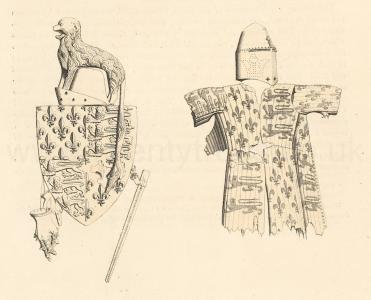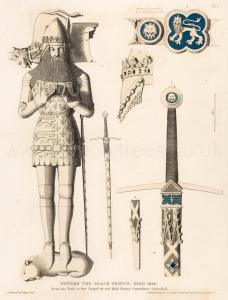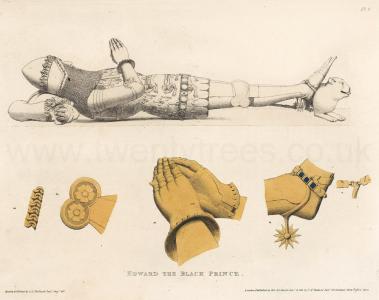Effigy of Edward, the Black Prince
Effigy of Edward, the Black Prince is in Monumental Effigies of Great Britain.
EDWARD, commonly called the Black Prince, eldest son of Edward III and Queen Philippa, was born at Woodstock [Map], on the 15th of June, 1330, 4th Edward III. Before he had attained his seventh year, the King, his father, granted to him the County of Chester, the Castles of Chester, Beeston, Rhyddlan [Map], Flint [Map], &c., and created him Duke of Cornwall. In the 17th Edward III. he was invested with a coronet, a gold ring, and a silver rod, as Prince of Wales. Three years after, in 1346, being then but sixteen years old, this valiant Prince fought and gained the battle of Cressy; and continued distinguishing himself in military achievements, till he won the field of Poitiers with 8 or 9,000 English against 60,000 French, taking John, King of France, prisoner: this battle was fought September 19th, 1356. In 1362, King Edward invested his gallant son with the Principality of Aquitainea. Here he did not long remain inactive; for Peter the Cruel, King of Spain, having been driven from his dominions, the Prince of Wales espoused his cause, passed with an army into Spain, and gained the battle of Najara, by which he restored an ungrateful Prince to a throne he had but too justly forfeited. Peter the Cruel once more reigning in his dominions, evaded paying the sums he had promised to the English Prince; who in order to discharge the expenses incurred by the war, had recourse to levying taxes in Aquitaine, which furnished a pretext for revolt in that province. In the midst of these difficulties the Black Prince died of a slow and lingering disorder, which first seized him in Spain; he expired on Trinity Sunday, in the Palace at Westminster, June 8th, 1376, aged 46.


Note a. The initial letter of this page, representing Edward III. giving to his son the Prince of Wales the grant of the Principality of Aquitaine, is taken from an illumination placed at the head of a copy of the grant, in the British Museum. Bibl*. Cotton*. Nero. D. 6.
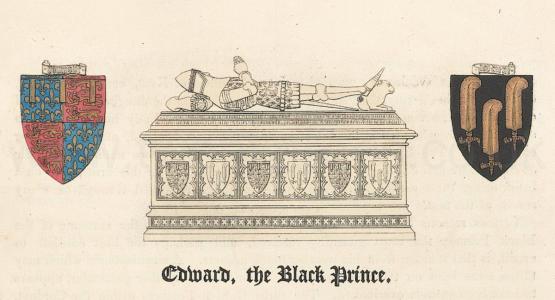
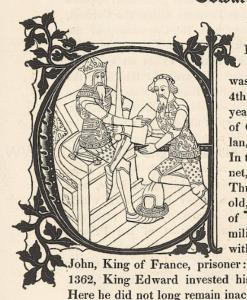
The Prince of Wales was married to Joan, Countess of Kent, commonly called, on account of her beauty, the Fair Maid of Kent. She was the daughter of Edmund of Woodstock, second son of Edward the First. By this Lady he had but two sons, Edward, who died at the age of seven years, and Richard, afterwards King of England. The Black Prince had also before marriage, two natural sons, Sir John Sounder and Sir Roger de Clarendon; the latter bore for his arms, Or, on a bend sable, three ostrich feathers argent; the quills transfixed through as many scrolls of the first.
Various reasons have been assigned for Edward's bearing the surname of the Black Prince; the most generally received, and perhaps the best entitled to credit, is that it arose from his wearing black armour. A circumstance which may throw some light on this point, and correct an error in another particular, appears to have been entirely overlooked. The three Ostrich Feathers within the Coronet, as at present borne, is generally understood to have been the Cognizance of the Black Prince, but on strict investigation, although his Will, his Seals, and his Tomb, give the most minute evidence on the subject, there exists no authority whatever for this disposition of the Ostrich Feathers. We are told that after the battle of Cressy, the banner of John, the old and blind King of Bohemia, there slain, was found in the field; upon it was wrought—sable, three ostrich feathers, with the motto Ich Dien; which cognizance, in memory of the day, was adopted by Prince Edward. By what authority this account is supported, is uncertain; but the German words Ich Dien and Houmont on the tomb, seem to give it probability. Although there is no farther proof that the feathers were borne by the King of Bohemia, yet it is not a little remarkable, that his granddaughter Anne, bore an ostrich as her Badge. Instead of the feathers either being worn within the coronet, or as a crest, the evidence on the tomb is contrary, they are borne as a coat, on an escutcheon. From the subjoined extract of the Prince's will, in the passage describing the man and horse, armed and covered with the badges, it is clear that the former bore them on his surcoat, and the latter on the bardinga. We cannot, therefore, be surprised, if the Prince of Wales wore such sable trappings, (which must be interred from the extract alluded to,) that he should have received the surname of the Black Prince. It may be necessary to remark, that the first notice of this surname occurs soon after the battle of Cressy.
Note a. There is a curious coincidence, bearing strong evidence on this point, in a beautiful manuscript, containing in French verse, an account of the iatter part of the life of Richard II written and illuminated by one who was an eyewitness to what he describes. In the second illumination Richard II is represented knighting Henry of Monmouth. The king is on horseback, in armour, his surcoat and the barding of the horse is powdered with ostrich feathers, and above him appears a pennon emblazoned in like manner. BibF. Harl".
Edward the Black Prince leaves to his son Richard in his will, "a blue vestment embroidered with gold roses and ostrich feathers." The feathers, and other devices of the Black Prince are also alluded to in the two following passages of the said Will:—"We give and devise our Hall of Ostrich Feathers of black Tapestry with a red border wrought with Swans with Ladies Heads, that is to say, a back piece, eight pieces for the sides and two for the Benches to the said Church of Canterbury, &c., &c."-" Item, we give and devise to our said son the Hall of Arras of the deeds of Saladyn, and also the Hall of worsted embroidered with Mermaids of the Sea, and the border paly red and black, embroidered with swans with Ladies Heads and Ostrich Feathers."
The first part of the Prince's Will which relates to his Tomb and Burial, is on many accounts so interesting here, that a translation from the French Originala, it is presumed, will not be unacceptable.
In the name of the Father, of the Son, and of the Holy Ghost, Amen. We Edward, eldest son of the King of England and of France, Prince of Wales, Duke of Cornwall, and Earl of Chester, the Seventh day of June, the year of Grace One Thousand, Three Hundred, and Seventy-six, in our Chamber within the Palace of our very redoubted Lord and Father at Westminster, being in good and sound memory, and having consideration to the short duration of human frailty, and as the time of the resolution of the divine will is not certain, and desiring always to be ready with the aid of God to his disposing, we ordain and make our Testament in the manner which follows. First we give our soul to God our Creator, and to the holy blessed Trinity, and to the glorious Virgin Mary, and to all the Saints: and our body to be buried in the Cathedral Church of the Trinity of Canterbury [Map], (where the body of the true martyr, my Lord St. Thomas, reposes,) in the middle of the Chapel of our Lady Undercroft, right before the Altar, so that the end of our Tomb towards the foot may be ten feet distant from the Altar; and that the same tomb shall be made of marble, of good masonry. And we will, that round the said Tomb shall be twelve escutcheons of laton , each of the breadth of a foot, six of which shall be of our arms entire, and the other six of ostrich feathers; and that upon each escutcheon shall be written, that is to say, upon those of our arms, and upon the others of ostrich feathers, And above the Tomb shall be made a table of laton overgilt, of the breadth and length of the same Tomb, upon which we will, that an image in relieved work of laton gilt, shall be placed in memory of us, all armed in steel for battle, with our arms quartered; and my visage, [et le visage mie] with our helmet of the leopard put under the head of the image. And we will, that upon our Tomb, in the place where it may be the most clearly seen and read, shall be written that which follows, in the manner that shall be best advised by our executorsb. * * * * * * And we will, that at that hour, that our body shall be brought into the town of Canterbury as far as to the Priory, that two coursers covered with our arms and two men armed in our arms, and in our helmets, shall go before our said body; that is to say, the one for war with our arms quartered, and the other for peace with our badges of ostrich feathers, with four banners of the same suit; and that every one of those who bear the said banners, shall have a chapeau of our arms; and that he who shall be armed for war, shall have a man armed bearing after him a black pennon with ostrich feathers. And we will, that the herse shall be made between the high Altar and the Choir, within which we will that our body shall be placed, until the vigils, masses, and the divine services shall be done; which services so done, our body shall be borne to the aforesaid Chapel of our Lady, where it shall be buried.
Note a. Preserved in the Archiepiscopal Registry at Lambeth.
Note b. As this epitaph is nearly the same as that on the tomb, it is omitted; but the inscription, giving the time of the Black Prince's death, with his titles, &c. &c., is not ordered in the above Will, although it is found on the tomb.
The Prince's Tomb is not in the Lady Chapel, as ordered in the Will, but on the south side of the Chapel of the Holy Trinity. In other respects it nearly agrees with the above order. The Tomb is of Sussex marble, divided into sixteen quatrefoiled panels, six on each side, two at the head, and two at the foot of the Tomb, in each of which are fixed escutcheons of copper, enamelled alternately with the arms and badges of the Black Prince. Above those, with the arms, is engraved on scrolls of copper, HOUMONT; and above those, with the badges in a similar manner, ICH DIENE. The effigy is of copper gilt, and lies upon the Tomb on a table of the same metal: it represents the Black Prince in armour, his head resting on his helmet, on which is the chapeau surmounted by a leopard crowned, having a file of three points about his neck. The countenance of the Prince possesses fine character. He is represented with long mustachios, which fall on each side over the camail, with which his face is closely enveloped; his beard is almost entirely concealed. On the bacinet is a rich coronet, the circle of which was once set with stones or glass. The manner of attaching the camail to the bacinet by the vervelles, or staples, with a silken lace, is here very clearly explaineda. The plates are very evident beneath the coat armour, which is emblazoned in relief with the arms of England and France quarterly, over all a file of three points. The gauntlets are armed with bosses or broches on the middle joints of the fingersb. The girdle is ornamented with gilt leopards' heads within circles, on a blue enamelled ground; in the centre within a quatrefoil, a leopard similarly enamelled. The sword is of the most beautiful workmanship. The pommel is ornamented with a leopard's head enamelled as the circles in the girdle. The hilt is of wirework. The sheath is richly wrought, engraved, and enamelled; its whole length is set with lapis lazuli in lozenges. The dagger is wanting. The solerets are of a preposterous length. It is uncertain what animal is intended at the feet. Considering how beautifully the whole of this figure is finished, it is singular that the armour is represented without either buckles, straps, or hinges. About the table of the Tomb are the inscriptions, engraved on plates of copper; the first is at the head of the Tomb, and the second commences on the south side and finishes on the north.
Note a. Pour six onces de soie de diverses couleurs a faire!es!as a mettre les camaux aus dits bacinets. Computum. Stepli. de la Fontaine, argentar. Reg. 1. Jan. 1349.
For six ounces of silk of various colours, to make laces to fasten the camails to the said bacinets.
Note b. In a Trial by Combat adjudged between John de Vesconti and Sir Thomas de la Marche, fought before Edward III in close Lists at Westminster; Sir Thomas de la Marche gained the advantage by striking the Rosses of Steel on his gauntlet, called Gadlings, into the face of his adversary.—Collin's Life of Edward Prince of Wales
Et riche bacinet li fist on apporter, [And on his bascinet his fist he brought?]
Caws a broches de fer, qui sont au redouter. [? haad iron pins, which are to be dreaded.]
MS. Bertrandi Guesclini.
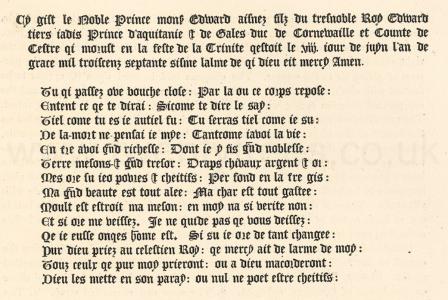
Over the tomb is a wooden canopy, carved and painted, on the underside of which is painted a representation of God the Father sustaining before him the Son on the Cross; at the angles are the symbols of the four Evangelists. The heads of the two principal personages have been effaced.
The military accoutrements of the Black Prince which are suspended by an iron rod above the tomb, are extremely curious; they are, perhaps, the most ancient remains of the kind existing, and, as might be expected, convey information on points which, but for such evidence, can be gained but by inference. The shield fastened to the column at the head of the tomb, is of wood, entirely covered with leather, wrought in such a manner, that the fleurs de lis and lions stand forth with a boldness of relief and finish, that when we consider the material employed, is truly wonderful; at the same time possessing even to this day a nature so firm and tough, that it must have been an excellent substitute for metal. This is, beyond doubt, the celebrated Cuirboullia, so often spoken of by the writers of the time. The surcoat, till closely examined, gives but little idea of its original splendour, as the whole is now in colour a dusky brown; it has short sleeves, and is made to lace up the centre of the back; its outward surface is velvet, once quarterly az and gules, upon which is richly embroidered with silk and gold, the lions and fleurs de lis; the whole of the surcoat is quilted, or gambased with cotton, to the thickness of three quarters of an inch, in narrow longitudinal portions, and lined with linen. It is remarkable, that there is no file either on this surcoat or the shield. The helmet is of iron, and has been lined within with leather; besides the sights tor the eyes, it has on the right side in front, a number of holes drilled in the form of a coronet, for the purpose of giving air to the wearer. The chapeau and leopard upon it, appear to be formed with cloth, covered with a white composition. The leopard is gilt, and the cap painted red; the facing white, with ermine spots, the inside lined with velvet. The gauntlets are brass, and remarkable for their similarity to those represented on the hands of the effigy, with this exception, that they have in addition, leopards, standing erect on the knuckles; the leather which appears on the inner side is ornamentally worked up the sides of the fingers with silk. The sword is said to have been taken away by Oliver Cromwell. The sheath which contained it yet remains, it appears to be leather, has been painted red, and ornamented on the outer side with gilt studs. There is yet a portion of the belt with the buckler attached; this belt is not of leather, but of cloth, the eighth of an inch thick, such as has been before noticed as used in fastening the spurs on the tomb of William de Valence.
Details—Plate 1, Fig. 1. Portion of the coronet, with the mode of fastening the camail to the bacinet, enlarged:—2, 3, and 4, parts of the sword and enamelled girdle. Plate 2, Fig. 1 and 2, the gauntlets which hang above the tomb, and those on the hands of the effigy, enlarged. 3. The spur and enamelled strap. 4. The mode in which the straps are attached to the spur on the inner side of the right foot. 5. Part of the coutes, or elbow-piece.
Note a. His Jambeux were of curebuly,
His sword shethe of Ivory. The Rhime of Sir Thopas Chaucer.
When the body of Henry V was brought from Rouen by Calais to England, a representation of the deceased king, made of Cuir Bouilli, painted and gilt, was placed on the top of the coffin.-Monstrelet.
